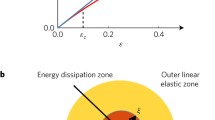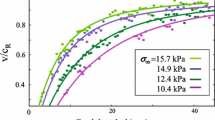Abstract
Peridynamics is a theory in solid mechanics that uses integral equations instead of partial differential equations as governing equations. It can be applied to fracture problems in contrast to the approach of fracture mechanics. In this paper by using peridynamics, the crack path for inclined crack under dynamic loading were investigated. The peridynamics solution for this problem represents the main features of dynamic crack propagation such as crack bifurcation. The problem is solved for various angles and different stress values. In addition, the influence of geometry on inclined crack growth is studied. The results are compared with molecular dynamic solutions that seem to show reasonable agreement in branching position and time.
Similar content being viewed by others
References
Rabczuk T. Computational Methods for Fracture in Brittle and Quasi-Brittle Solids: State-of-the-Art Review and Future Perspectives. ISRN Applied Mathematics, 2013: 1–38
Zehnder A. Fracture Mechanics. Springer Netherlands, 2012
Rabczuk T, Bordas S, Zi G. On three-dimensional modelling of crack growth using partition of unity methods. Computers & Structures, 2010, 88(23–24): 1391–1411
Areias P, Rabczuk T, Camanho P P. Initially rigid cohesive laws and fracture based on edge rotations. Computational Mechanics, 2013, 52(4): 931–947
Amiri F, Anitescu C, Arroyo M, Bordas S, Rabczuk T. XLME interpolants, a seamless bridge between XFEM and enriched meshless methods. Computational Mechanics, 2014, 53(1): 45–57
Rabczuk T, Gracie R, Song J H, Belytschko T. Immersed particle method for fluid-structure interaction. International Journal for Numerical Methods in Engineering, 2010, (81): 48–71
Ravi-Chandar. Dyanamic Fracture. Elsevier, 2004
Areias PMA, Rabczuk T, Camanho P P. Finite strain fracture of 2D problems with injected anisotropic softening elements. Theoretical and Applied Fracture Mechanics, 2014, 72: 50–63
Rabczuk T, Zi G, Bordas S, Nguyen-Xuan H. A simple and robust three-dimensional cracking-particle method without enrichment. Computer Methods in Applied Mechanics and Engineering, 2010, 199(37–40): 2437–2455
Song J, Wang H, Belytschko T. A comparative study on finite element method for dynamic fracture. Computational Mechanics, 2008, 42(2): 239–250
Rabczuk T, Belytschko T. Cracking particles: a simplified meshfree method for arbitrary evolving cracks. International Journal for Numerical Methods in Engineering, 2004, 61(13): 2316–2343
Rabczuk T, Bordas S, Zi G. A three-dimensional meshfree method for continuous multiple-crack initiation, propagation and junction in statics and dynamics. Computational Mechanics, 2007, 40(3): 273–495
Areias P, Rabczuk T. Finite strain fracture of plates and shells with configurational forces and edge rotation. International Journal for Numerical Methods in Engineering, 2013, 94(12): 1099–1122
Silling S. Reformulation of elasticity theory for discontinuities and long-rang forces. Journal of the Mechanics and Physics of Solids, 2000, 48(1): 175–209
Silling S, Lehoucq R. Peridynamic theory of solid mechanics. Advances in Applied Mechanics, 2010, 44(10): 73–168
Talebi H, Silani M, Bordas S P A, Kerfriden P, Rabczuk T. Molecular dynamics/XFEM coupling by a three-dimensional extended bridging domain with applications to dynamic brittle fracture. International Journal for Multiscale Computational Engineering, 2013, 11(6): 527–541
Budarapu P, Gracie R, Bordas S, Rabczuk T. An adaptive multiscale method for quasi-static crack growth. Computational Mechanics, 2014, 53(6): 1129–1148
Rahman R, Foster J T, Haque A. A multiscale modeling scheme based on peridynamic theory. International Journal of Multiscale Computational Engineering, 2014, 12(3): 223–248
Parks M, Lehoucq R, Plimpton S, Silling S. Implementing peridynamics within a molecular dynamics code. Computer Physics Communications, 2008, 179: 777–783
Parks M, Seleson P, Plimpton S, Lehoucq R, Silling S. Peridynamics with LAMMPS: A User Guide v0.2 Beta, Sandia Report, 2010
Silling S, Weckner O, Askari E, Bobaru F. Crack nucleation in a peridynamic solid. International Journal of Fracture, 2010, 162(1–2): 219–227
Madenci E, Oterkus E. Peridynamics theory and its applications. New York: Springer-Verlag, 2014
Kilic B, Madenci E. Peridiction of crack paths in a quenched glass plate by using peridynamic theory. International Journal of Fracture, 2009, 156(2): 165–177
Ha Y D, Bobaru F. Studies of dynamic crack propagation and crack branching with Peridynamics. International Journal of Fracture, 2010, 162(1–2): 229–244
Ha Y D, Bobaru F. Characteristics of dynamic brittle fracture captured with Peridynamics. Engng Fract Mech, 2011 (78): 1156–1168
Ren H, Zhuang X, Rabczuk T. Dual-horizon peridynamics: a stable solution to varying horizons. Computer Methods in Applied Mechanics and Engineering, 2017, 318: 762–782
Ren H, Zhuang X, Cai Y, Rabczuk T. Dual-Horizon Peridynamics. International Journal for Numerical Methods in Engineering, 2016, 108(12): 1451–1476
Silling S, Askari E. A mesh free method based on the peridynamic model of solid Mechanics. Comput Struct, 2005, 83(17): 1526–1535
Sticker B, Schachinger E. Basic Concepts in Computational Physics. Springer, 2014
Author information
Authors and Affiliations
Corresponding author
Rights and permissions
About this article
Cite this article
Shafiei, A. Dynamic crack propagation in plates weakened by inclined cracks: an investigation based on peridynamics. Front. Struct. Civ. Eng. 12, 527–535 (2018). https://doi.org/10.1007/s11709-018-0450-1
Received:
Accepted:
Published:
Issue Date:
DOI: https://doi.org/10.1007/s11709-018-0450-1




